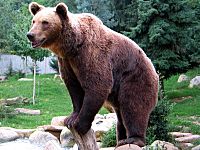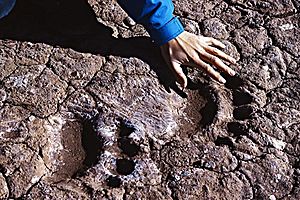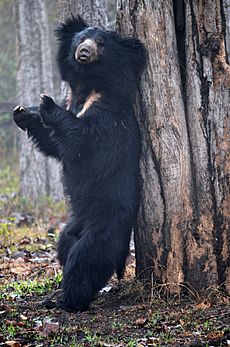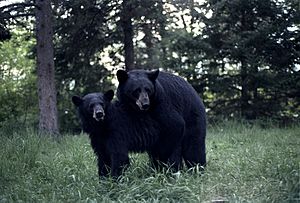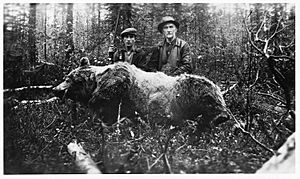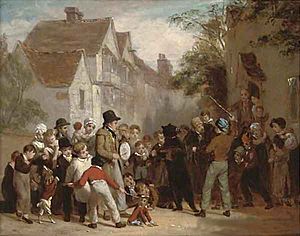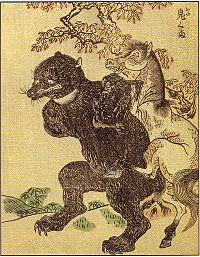Bear facts for kids
Quick facts for kids BearTemporal range: late Eocene – Recent
|
|
|---|---|
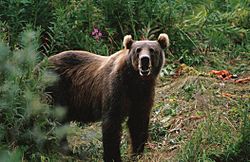 |
|
| A Kodiak brown bear | |
| Scientific classification | |
| Kingdom: | |
| Phylum: | |
| Class: | |
| Order: | |
| Suborder: | |
| Family: |
Ursidae
|
| Genera | |
Bears are carnivoran mammals of the family Ursidae. Bears are classified as caniforms, or doglike carnivorans. Although only eight species of bears are extant, they are widespread, appearing in a wide variety of habitats throughout the Northern Hemisphere and partially in the Southern Hemisphere. Bears are found on the continents of North America, South America, Europe, and Asia. Common characteristics of modern bears include large bodies with stocky legs, long snouts, small rounded ears, shaggy hair, plantigrade paws with five nonretractile claws, and short tails.
While the polar bear is mostly carnivorous, and the giant panda feeds almost entirely on bamboo, the remaining six species are omnivorous with varied diets.
Bears are typically solitary animals. They may be diurnal or nocturnal and have an excellent sense of smell. Despite their heavy build and awkward gait, they are adept runners, climbers, and swimmers. Bears use shelters, such as caves and logs, as their dens; most species occupy their dens during the winter for a long period of hibernation, up to 100 days.
Bears have been hunted since prehistoric times for their meat and fur; they have been used for bear-baiting and other forms of entertainment, such as being made to dance.
Contents
Etymology
The English word "bear" comes from Old English bera and belongs to a family of names for the bear in Germanic languages, such as Swedish björn, also used as a first name, that originate from an adjective meaning "brown".
Evolution and phylogeny
The family Ursidae is one of nine families in the suborder Caniformia, or "doglike" carnivorans, within the order Carnivora. Bears' closest living relatives are the pinnipeds, canids, and musteloids. Modern bears comprise eight species in three subfamilies: Ailuropodinae (monotypic with the giant panda), Tremarctinae (monotypic with the spectacled bear), and Ursinae (containing six species divided into one to three genera, depending on the authority).
Paleontology
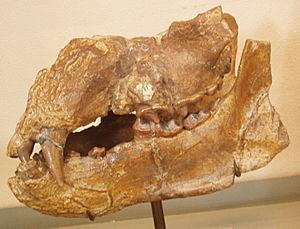
The earliest members of Ursidae belong to the extinct subfamily Amphicynodontinae, including Parictis (late Eocene to early middle Miocene, 38–18 Mya) and the slightly younger Allocyon (early Oligocene, 34–30 Mya), both from North America. These animals looked very different from today's bears, being small and raccoon-like in overall appearance, and diets perhaps more similar to that of a badger.
The raccoon-sized, dog-like Cephalogale is the oldest-known member of the subfamily Hemicyoninae, which first appeared during the middle Oligocene in Eurasia about 30 Mya.
The New World short-faced bears (Tremarctinae) differentiated from Ursinae following a dispersal event into North America during the mid-Miocene (about 13 Mya). They invaded South America (≈1 Ma) following formation of the Isthmus of Panama.
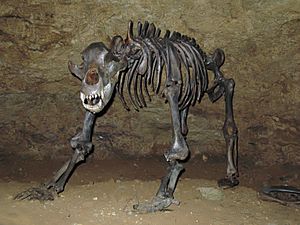
The sloth bear is a modern survivor of one of the earliest lineages to diverge during this radiation event (5.3 Mya); it took on its peculiar morphology, related to its diet of termites and ants, no later than by the early Pleistocene. By 3–4 Mya, the species Ursus minimus appears in the fossil record of Europe; apart from its size, it was nearly identical to today's Asian black bear. It is likely ancestral to all bears within Ursinae, perhaps aside from the sloth bear. Two lineages evolved from U. minimus: the black bears (including the sun bear, the Asian black bear, and the American black bear); and the brown bears (which includes the polar bear). Modern brown bears evolved from U. minimus via Ursus etruscus, which itself is ancestral to the extinct Pleistocene cave bear. Species of Ursinae have migrated repeatedly into North America from Eurasia as early as 4 Mya during the early Pliocene. The polar bear is the most recently evolved species and descended from the brown bear around 400,000 years ago.
Phylogeny
The bears form a clade within the Carnivora. The red panda is not a bear but a musteloid. The cladogram is based on molecular phylogeny of six genes in Flynn, 2005.
| Carnivora |
|
||||||||||||||||||||||||||||||||||||
The phylogeny of extant bear species is shown in a cladogram based on complete mitochondrial DNA sequences from Yu et al., 2007. The giant panda, followed by the spectacled bear are clearly the oldest species. The relationships of the other species are not very well resolved, though the polar bear and the brown bear form a close grouping.
| Ursidae |
|
||||||||||||||||||||||||||||||||||||||||||
Physical characteristics
Size
Bears include the most massive extant terrestrial members of the order Carnivora. Polar bears weigh up to 1,600 lb (730 kg). The smallest are the sun bears of Asia, which weigh up to 150 lb (68 kg). Body weight varies throughout the year in bears of temperate and arctic climates, as they build up fat reserves in the summer and autumn and lose weight during the winter. Head-and-body length can range from 150 cm (59 in) in sun bears to 244 cm (96 in) in polar bears.
Morphology
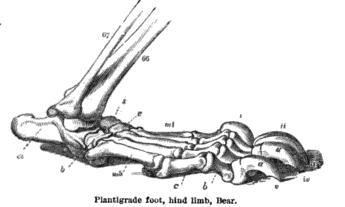
Bears are generally bulky and robust animals with short tails. They are sexually dimorphic with regard to size, with the males being larger. Relying as they do on strength rather than speed, bears have relatively short limbs with thick bones to support their bulk. The strong forelimbs are used to catch prey, to excavate dens, to dig out burrowing animals, to turn over rocks and logs to locate prey, and to club large creatures.
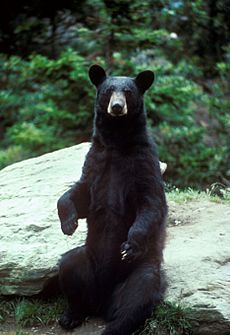
Unlike most other land carnivorans, bears are plantigrade. They distribute their weight toward the hind feet, which makes them look lumbering when they walk. Their front paws are flexible enough to grasp fruit and leaves. Bears' non-retractable claws are used for digging, climbing, tearing, and catching prey.
Their shaggy coat helps maintain body heat during winter hibernation and is shed in the spring leaving a shorter summer coat. Polar bears have hollow, translucent guard hairs which gain heat from the sun and conduct it to the dark-coloured skin below. They have a thick layer of blubber for extra insulation, and the soles of their feet have a dense pad of fur. Other than the bold black-and-white pelage of the panda, bears tend to be uniform in colour, although some species may have markings on the chest or face.
Bears have small rounded ears so as to minimise heat loss, but neither their hearing or sight are particularly acute. Unlike many other carnivorans they have colour vision, perhaps to help them distinguish ripe nuts and fruits.
The skulls of bears are massive, providing anchorage for the powerful masseter and temporal jaw muscles. The canine teeth are large but mostly used for display, and the molar teeth flat and crushing.
Bears have a fairly simple digestive system typical for carnivorans, with a single stomach.
Distribution and habitat
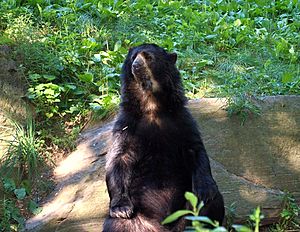
Extant bears are found in sixty countries primarily in the Northern Hemisphere and are concentrated in Asia, North America, and Europe. An exception is the spectacled bear; native to South America, it inhabits the Andean region. The sun bear's range extends below the equator in Southeast Asia. The Atlas bear, a subspecies of the brown bear was distributed in North Africa from Morocco to Libya, but it became extinct around the 1870s.
The most widespread species is the brown bear, which occurs from Western Europe eastwards through Asia to the western areas of North America. The American black bear is restricted to North America, and the polar bear is restricted to the Arctic Sea. All the remaining species of bear are Asian. They occur in a range of habitats which include tropical lowland rainforest, both coniferous and broadleaf forests, prairies, steppes, montane grassland, alpine scree slopes, Arctic tundra and in the case of the polar bear, ice floes. Bears may dig their dens in hillsides or use caves, hollow logs and dense vegetation for shelter.
Behaviour and life history
Brown and American black bears are generally diurnal, meaning that they are active for the most part during the day, though they may forage substantially by night. Other species may be nocturnal, active at night, though female sloth bears with cubs may feed more at daytime to avoid competition from conspecifics and nocturnal predators.
Bears are overwhelmingly solitary and are considered to be the most asocial of all the Carnivora. The only times bears are encountered in small groups are mothers with young or occasional seasonal bounties of rich food (such as salmon runs).
Feeding
Most bears are opportunistic omnivores and consume more plant than animal matter. They eat anything from leaves, roots, and berries to insects, carrion, fresh meat, and fish, and have digestive systems and teeth adapted to such a diet. At the extremes are the almost entirely herbivorous giant panda and the mostly carnivorous polar bear. However, all bears feed on any food source that becomes seasonally available. For example, Asiatic black bears in Taiwan consume large numbers of acorns when these are most common, and switch to ungulates at other times of the year.
When foraging for plants, bears choose to eat them at the stage when they are at their most nutritious and digestible, typically avoiding older grasses, sedges and leaves. Brown bears, with their powerful digging abilities, commonly eat roots. The panda's diet is over 99% bamboo, of 30 different species. Its strong jaws are adapted for crushing the tough stems of these plants, though they prefer to eat the more nutritious leaves. Bromeliads can make up to 50% of the diet of the spectacled bear, which also has strong jaws to bite them open.
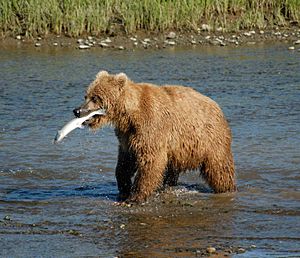
The sloth bear, though not as specialised as polar bears and the panda, has lost several front teeth usually seen in bears, and developed a long, suctioning tongue to feed on the ants, termites, and other burrowing insects they like.
The brown bear and both species of black bears sometimes take large ungulates, such as deer and bovids, mostly the young and weak. These animals may be taken by a short rush and ambush, though hiding young may be stiffed out and pounced on. The polar bear mainly preys on seals, stalking them from the ice or breaking into their dens. They primarily eat the highly digestible blubber. Large mammalian prey is typically killed by a bite to the head or neck, or (in the case of young) simply pinned down and mauled. Predatory behaviour in bears is typically taught to the young by the mother.
Bears are prolific scavengers, stealing food caches from rodents, and carcasses from other predators.
For hibernating species, weight gain is important as it provides nourishment during winter dormancy. A brown bear can eat 41 kg (90 lb) of food and gain 2–3 kg (4.4–6.6 lb) of fat a day prior to entering its den.
Communication
Bears produce a number of vocal and non-vocal sounds. Tongue-clicking, grunting or chuffing many be made in cordial situations, such as between mothers and cubs or courting couples, while moaning, huffing, sorting or blowing air is made when an individual is stressed. Barking is produced during times of alarm, excitement or to give away the animal's position. Warning sounds include jaw-clicking and lip-popping, while teeth-chatters, bellows, growls, roars and pulsing sounds are made in aggressive encounters. Cubs may squeal, bawl, bleat or scream when in distress and make motor-like humming when comfortable or nursing.
Bears sometimes communicate with visual displays such as standing upright, which exaggerates the individual's size. The chest markings of some species may add to this intimidating display. Staring is an aggressive act and the facial markings of spectacled bears and giant pandas may help draw attention to the eyes during agonistic encounters. Individuals may approach each other by stiff-legged walking with the head lowered. Dominance between bears is asserted by making a frontal orientation, showing the canine teeth, muzzle twisting and neck stretching. A subordinate may respond with a lateral orientation, by turning away and dropping the head and by sitting or lying down.
Bears may mark territory by rubbing against trees and other objects which may serve to spread their scent. This is usually accompanied by clawing and biting the object. Bark may be spread around to draw attention to the marking post. Pandas are known to mark objects with urine and a waxy substance from their anal glands. Polar bears leave behind their scent in their tracks which allow individuals to keep track of one another in the vast Arctic wilderness.
Reproduction and life cycle
During the breeding season, males take notice of females in their vicinity and females become more tolerant of males. A male bear may visit a female continuously over a period of several days or weeks, depending on the species, to test her reproductive state. During this time period, males try to prevent rivals from interacting with their mate. Courtship may be brief, although in some Asian species, courting pairs may engage in wrestling, hugging, mock fighting and vocalising.
Gestation typically lasts 6–9 months, including delayed implantation, and litter size numbers up to four cubs. Giant pandas may give birth to twins but they can only suckle one young and the other is left to die. In northern living species, birth takes place during winter dormancy.
Cubs are born blind and helpless with at most a thin layer of hair, relying on their mother for warmth. The milk of the female bear is rich in fat and antibodies and cubs may suckle for up to a year after they are born. By 2–3 months, cubs can follow their mother outside the den. They usually follow her on foot, but sloth bear cubs may ride on their mother's back. Male bears play no role in raising young.
In some species, offspring may become independent around the next spring, through some may stay until the female successfully mates again. Bears reach sexual maturity shortly after they disperse; at around 3–6 years depending on the species. Male Alaskan brown bears and polar bears may continue to grow until they are 11 years old. Lifespan may also vary between species. The brown bear can live an average of 25 years.
Hibernation
Bears of northern regions, including the American black bear and the grizzly bear, hibernate in the winter. During hibernation, the bear's metabolism slows down, its body temperature decreases slightly, and its heart rate slows from a normal value of 55 to just 9 beats per minute. Bears normally do not wake during their hibernation, and can go the entire period without eating, drinking, urinating, or defecating. A fecal plug is formed in the colon, and is expelled when the bear wakes in the spring. If they have stored enough body fat, their muscles remain in good condition, and their protein maintenance requirements are met from recycling waste urea. Female bears give birth during the hibernation period, and are roused when doing so.
Predators
As animals at the summit of the food chain, bears do not have many predators. The most important are humans, and as they started cultivating crops, they increasingly came in conflict with the bears that raided them. Since the invention of firearms, people have been able to kill bears with greater ease. The tiger is the only four-legged predator that regularly preys on adult bears, including brown bears, sloth bears, Asiatic black bears, and sun bears.
Relationship with humans
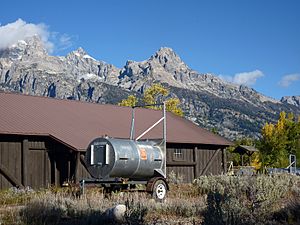
Conservation
In modern times, bears have come under pressure through encroachment on their habitats and illegal trade in bear parts, including the Asian bile bear market, though hunting is now banned, largely replaced by farming. The IUCN lists six bear species as vulnerable; even the two least concern species, the brown bear and the American black bear, are at risk of extirpation in certain areas. In general these two species inhabit remote areas with little interaction with humans, and the main non-natural causes of mortality are hunting, trapping, road-kill and depredation.
Laws have been passed in many areas of the world to protect bears from habitat destruction. Public perception of bears is often positive, as people identify with bears due to their omnivorous diets, their ability to stand on two legs, and their symbolic importance. Support for bear protection is widespread, at least in more affluent societies. Where bears raid crops or attack livestock, they may come into conflict with humans. In poorer rural regions, attitudes may be more shaped by the dangers posed by bears and the economic costs they cause to farmers and ranchers.
Attacks
Several bear species are dangerous to humans, especially in areas where they have become used to people; elsewhere, they generally avoid humans. Injuries caused by bears are rare, but are widely reported. Bears may attack humans in response to being startled, in defense of young or food, or even for predatory reasons.
Entertainment, hunting, food and folk medicine
Bears in captivity have for centuries been used for entertainment. They have been trained to dance, and were kept for baiting in Europe at least since the 16th century. There were five bear-baiting gardens in Southwark, London at that time; archaeological remains of three of these have survived. Across Europe, nomadic Romani bear handlers called Ursari lived by busking with their bears from the 12th century.

Bears have been hunted for sport, food, and folk medicine. Their meat is dark and stringy, like a tough cut of beef. In Cantonese cuisine, bear paws are considered a delicacy. Bear meat should be cooked thoroughly, as it can be infected with the parasite Trichinella spiralis.
The peoples of eastern Asia use bears' body parts and secretions (notably their gallbladders and bile) as part of traditional Chinese medicine. More than 12,000 bears are thought to be kept on farms in China, Vietnam, and South Korea for the production of bile. Trade in bear products is prohibited under CITES, but bear bile has been detected in shampoos, wine and herbal medicines sold in Canada, the United States and Australia.
Literature, art and symbolism
There is some evidence of prehistoric bear worship. The prehistoric Finns, Siberian peoples and more recently Koreans considered the bear as the spirit of their forefathers. There is evidence of bear worship in early Chinese and Ainu cultures.
In many Native American cultures, the bear is a symbol of rebirth because of its hibernation and re-emergence. The image of the mother bear was prevalent throughout societies in North America and Eurasia, based on the female's devotion and protection of her cubs. Japanese folklore features the Onikuma, a "demon bear" that walks upright. The Ainu of northern Japan, a different people from the Japanese, saw the bear instead as sacred; Hirasawa Byozan painted a scene in documentary style of a bear sacrifice in an Ainu temple, complete with offerings to the dead animal's spirit.
Artio (Dea Artio in the Gallo-Roman religion) was a Celtic bear goddess. Evidence of her worship has notably been found at Bern, itself named for the bear. Her name is derived from the Celtic word for "bear", artos. In ancient Greece, archaic cult of Artemis in bear form survived into Classical times at Brauron, where young Athenian girls passed an initiation right as arktai "she bears". For Artemis and one of her nymphs as a she-bear, see the myth of Callisto.
The constellations of Ursa Major and Ursa Minor, the great and little bears, are named for their supposed resemblance to bears, from the time of Ptolemy.
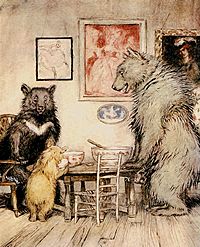
Bears are popular in children's stories, including Winnie the Pooh, Paddington Bear, Gentle Ben and "The Brown Bear of Norway". An early version of "Goldilocks and the Three Bears", was published as "The Three Bears" in 1837 by Robert Southey, many times retold, and illustrated in 1918 by Arthur Rackham.
The cartoon character Yogi Bear has appeared in numerous comic books, animated television shows and films. The Care Bears began as greeting cards in 1982, and were featured as toys, on clothing and in film. Around the world, many children—and some adults—have teddy bears, stuffed toys in the form of bears, named after the American statesman Theodore Roosevelt when in 1902 he had refused to shoot an American black bear tied to a tree.
The Russian Bear has been a common national personification for Russia from the 16th century onwards.
Smokey Bear has become a part of American culture since his introduction in 1944, with his message "Only you can prevent forest fires". In the UK, the bear and staff feature on the heraldic arms of the county of Warwickshire. Bears appear in the canting arms of two cities, Bern and Berlin.
Organizations
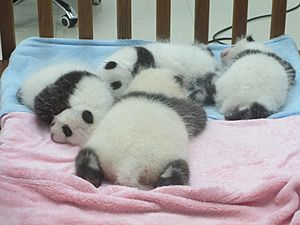
The International Association for Bear Research & Management, also known as the International Bear Association, and the Bear Specialist Group of the Species Survival Commission, a part of the International Union for Conservation of Nature focus on the natural history, management, and conservation of bears. Bear Trust International works for wild bears and other wildlife through four core program initiatives, namely Conservation Education, Wild Bear Research, Wild Bear Management, and Habitat Conservation.
Related pages
- Giant panda, Ailuropoda melanoleuca
- Spectacled bear, Tremarctos ornatus
- Brown bear, Ursus arctos
- Polar bear, Ursus maritimus
- American black bear, Ursus americanus
- Asian black bear, Ursus thibetanus or Selenarctos thibetanus
- Sloth bear, Melursus ursinus
- Sun bear, Ursus malayanus
Images for kids
-
The brown bear photographed near the Russian border in the forests of Kainuu, Finland.
-
American black bear tracks at Superior National Forest, Minnesota, U.S.
See also
 In Spanish: Ursidae para niños
In Spanish: Ursidae para niños


